Mabie Todd Swan Visofil V Series 1935-1936
by Jim Mamoulides, first published September 10, 2002, updates with Laurence Oldfield January 19, 2003, and May 31, 2003. with Steve Hull June 30, 2004, and updated on January 9, 2023
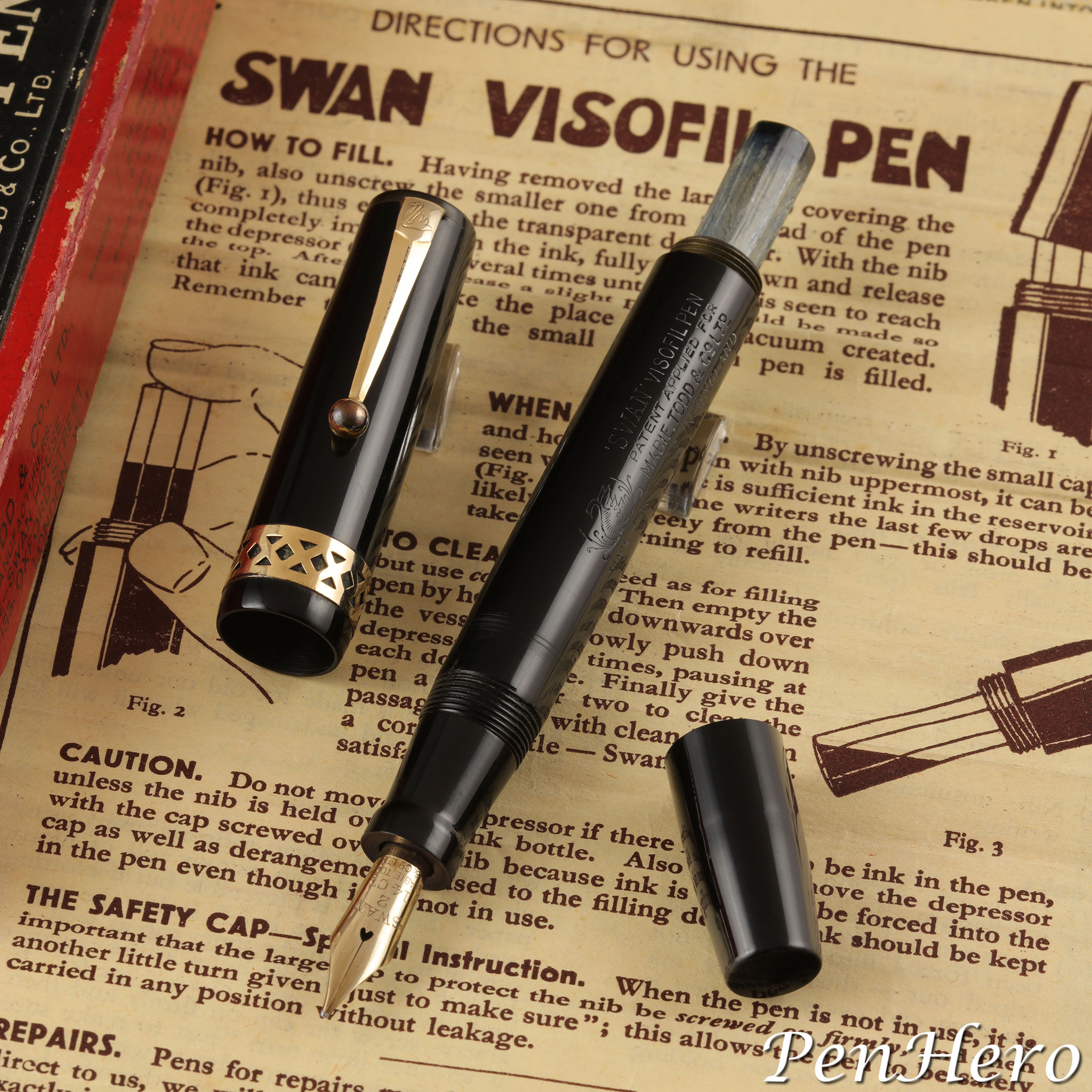 Mabie Todd Swan Visofil V-Series V211/60 Black
Mabie Todd Swan Visofil V-Series V211/60 Black
Visualization is all the rage
Innovations in fountain pen design came in many forms over the last 150 years. Many of them focused on the filling mechanism to make the pen easier, cleaner, and quicker to fill. Early designs intended to do away with messy eyedropper filling included ink cartridges, such as the April 29, 1890, patented Eagle glass cartridge pen, and many types that used rubber sacs such as lever- fillers, Crocker’s blow filler, and Parker’s button filler, just to name a few examples. Solutions to make the pen capable of writing longer looked at increasing ink capacity by directly filling the barrel. Pens like the early-1920s Dunn pump-filler pen also offered a clear barrel. The Postal Reservoir Pen, made from about 1925 to 1928, was a bulb filler with a clear barrel. These pens also address another question: “How much ink do I have left?”
Though the original Conklin Nozac, released in 1931, had an opaque barrel, Conklin very quickly introduced models with a large visible section in the top part of the barrel. The first English-made fully ink-visible pen was Ford’s Patent Pen, introduced in August 1931. Parker’s Vacumatic, introduced in 1932 as the Golden Arrow, was a plunger filler that used a rubber diaphragm to fill the ink-visible barrel and was a major sales success. Sheaffer introduced a plunger filling mechanism that filled the ink-visible barrel as the Vacuum-Fil in 1934, which was quickly incorporated into the main Sheaffer line.
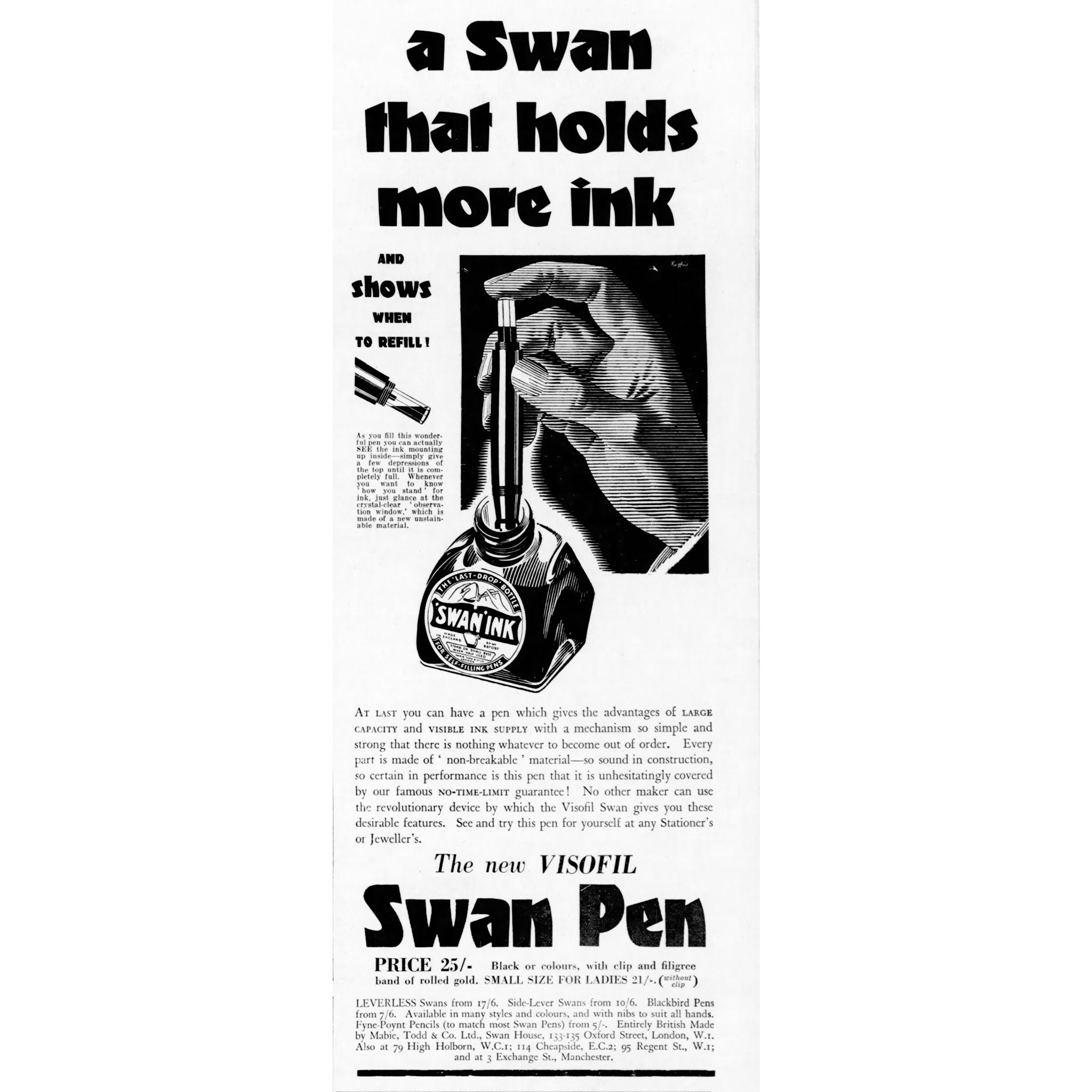 Earliest known Visofil advertisement, dated October 18, 1935
Earliest known Visofil advertisement, dated October 18, 1935
Mabie Todd entered this market somewhat late, introducing the Visofil plunger-filling pen in 1935. The pen was principally for the English and European market, selling in England at the premium price of 25 shillings. Unlike the Parker Duofold and Sheaffer Jade Senior, which were priced high during a decade of economic growth, the Visofil was introduced in the middle of the Great Depression, when money was very tight. The pen proved not to be a major sales success, making examples now more difficult to find, but it is prized by some collectors. These pens are probably so uncommon in North America because by the time of the model’s release, Mabie Todd was winding down US operations. It’s interesting to note that many pens sought for by collectors today, such as the Parker Duofold Mandarin and the Sheaffer PFM, were also high-quality pens that failed to captivate the market at the time.
The Visofil V Series is a uniquely designed ink sac pen with a hollow transparent plunger that allows the user to view the ink level. This design gives the benefit of increased ink capacity, as the sac extends the full length of the barrel from the section nipple to the plunger. The V Series has a very long breather tube, an early use of this device, which allows the pen to fill almost completely with a reduced number of strokes.
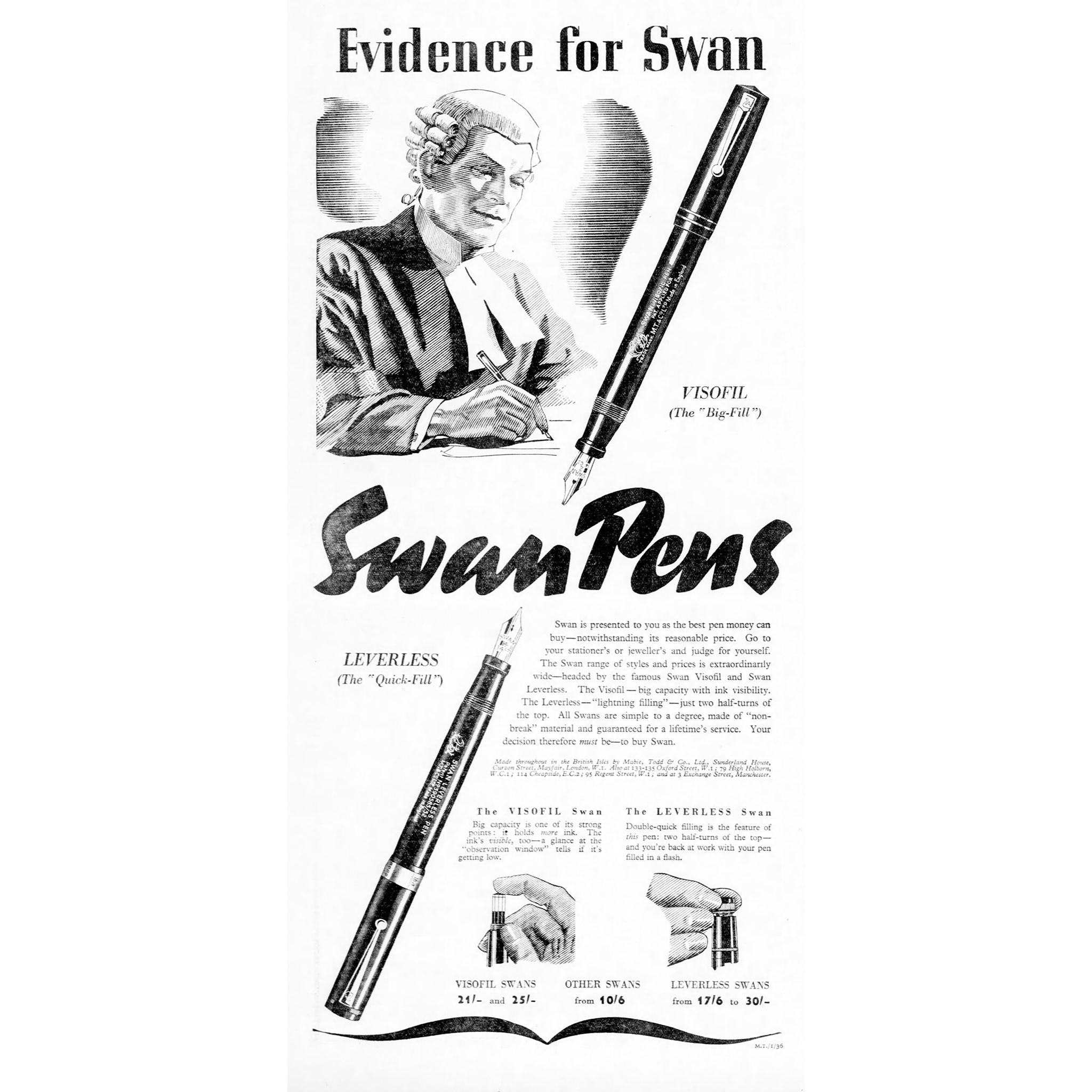 Swan advertisement showing Visofil and Leverless pens dated October 9, 1936
Swan advertisement showing Visofil and Leverless pens dated October 9, 1936
There are two types of Visofil pens. UK Patent 451,275 on the earlier V series, or Mark 1 was awarded on July 31, 1936 to Edward Stephen Sears and Mabie Todd and Company Limited as an “ink visible pen with increased ink capacity.” US Patent 2,056,055 was awarded shortly afterward on September 29, 1936. The patent for what became the V Series pen shows a long blind cap, being almost one third the length of the barrel, which covers a large, octagonal, clear plastic plunger, similar in size to a Parker Speedline Vacumatic plunger and externally gives the pen a similar look. The plunger provides a view to the ink remaining in the pen, giving the user an idea of how soon refilling will be needed.
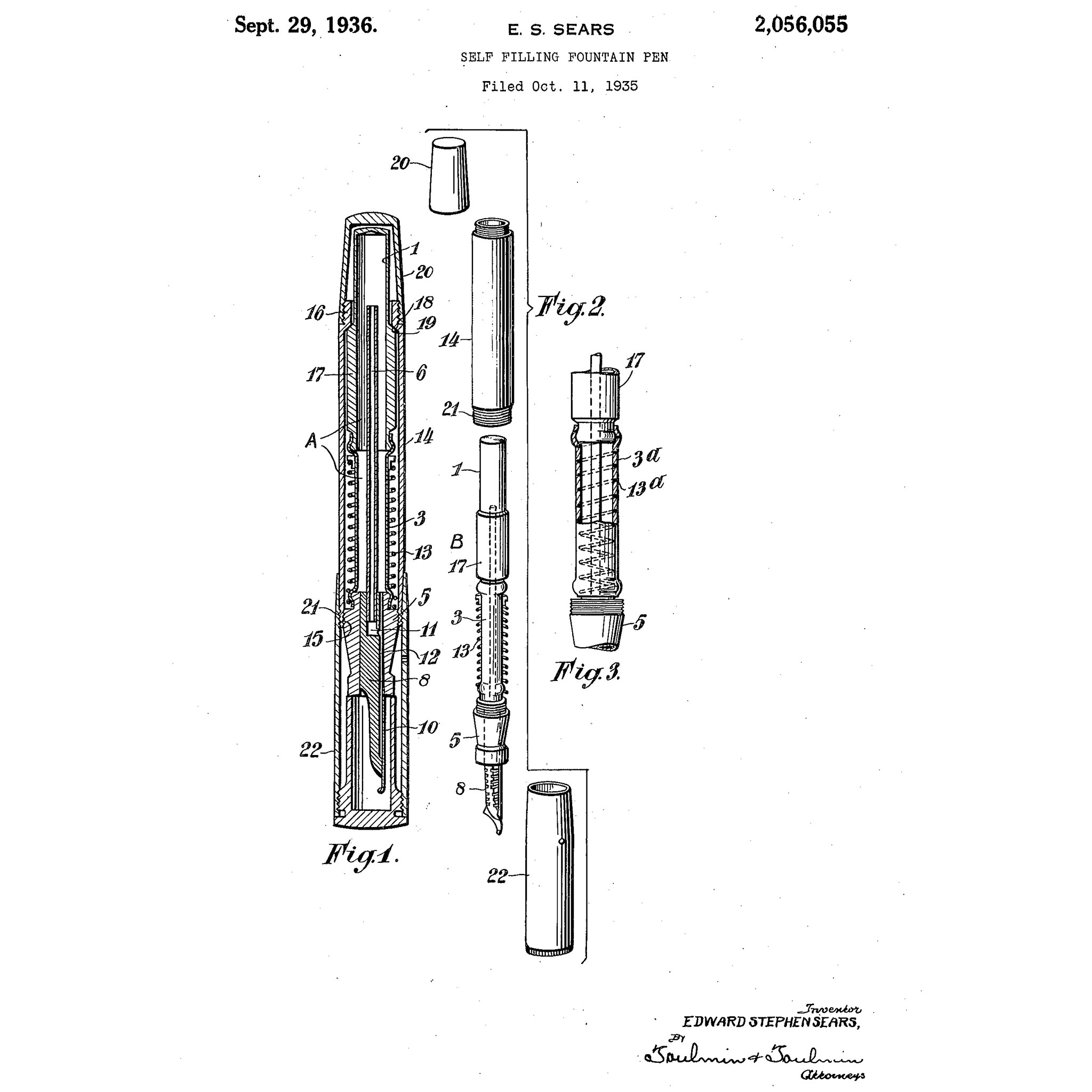 Illustration from the September 29, 1936 US patent
Illustration from the September 29, 1936 US patent
The Visofil V Series line was made only in England. Production was from September 1935 until September 1937, when the replacement VT series was introduced. The VT differed as it was a plunger type that used a diaphragm to fill the ink visible barrel. The VT series probably ceased production in early 1942, according to research done by Steve Hull. Mabie Todd did not renew production of the Visofil line after the World War II.
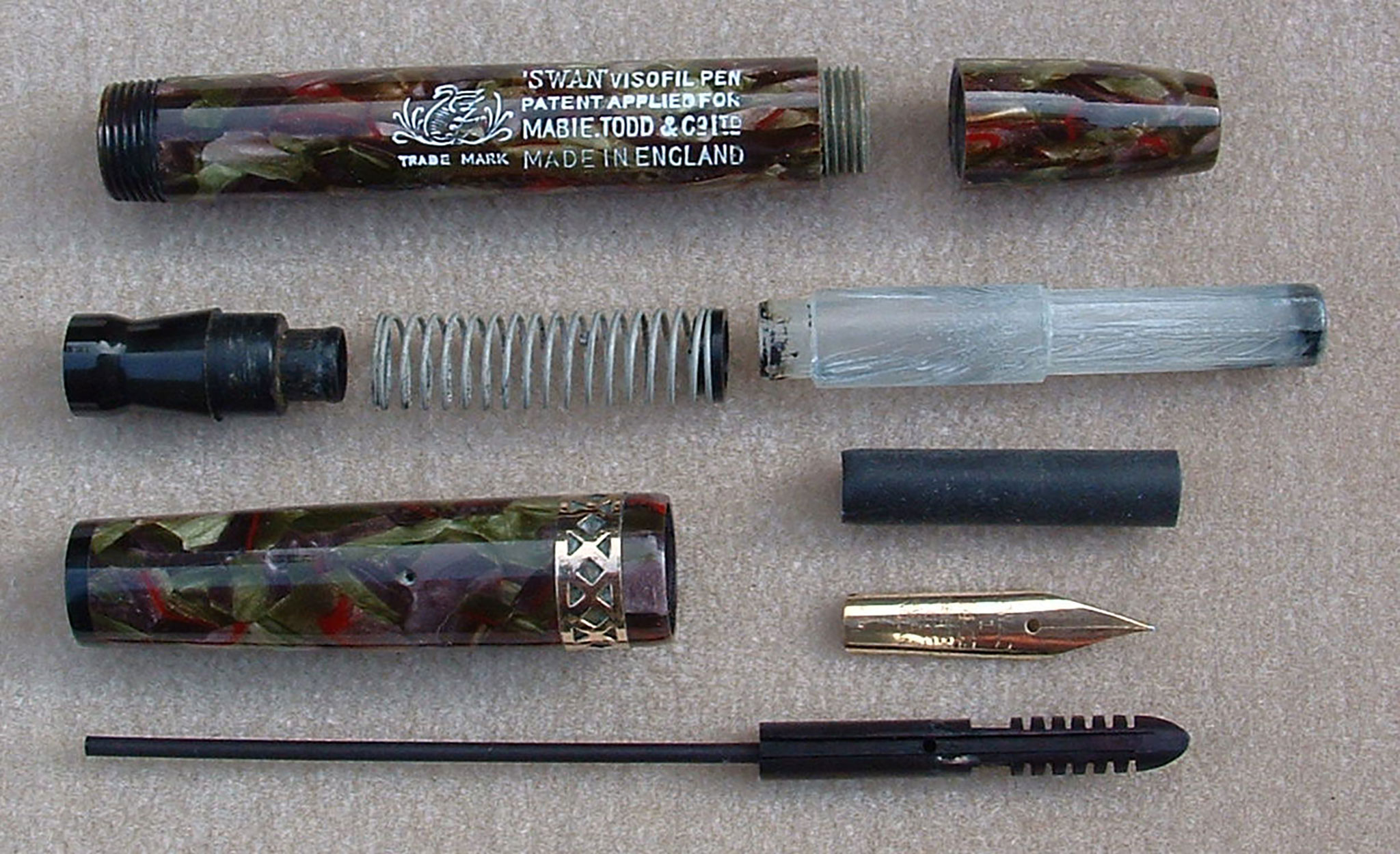 Mabie Todd Swan Visofil 'V' Series Italian Marble Small Ladies' Model exploded viewPhoto courtesy Laurence Oldfield
Mabie Todd Swan Visofil 'V' Series Italian Marble Small Ladies' Model exploded viewPhoto courtesy Laurence Oldfield
In his article “Mechanisms Revealed—1. The Swan Visofil,” Laurence Oldfield notes, “The pen as actually produced differs only in detail from the patent, as can be seen from the parts: its operation is elegant and a natural development from pre-existing designs. The transparent hexagonal ink reservoir is an extension of the rubber sac and acts as a push button to compress the sac longitudinally against the action of a surrounding spring. The filler is prevented from rotating by a hexagonally bored brass bush fixed to the end of the barrel. This also provides attachment for the blind cap.”
The V-series Visofil came initially with a filigree cap band and in an assortment of colors. The Mabie Todd color names were black; Russet and Jade; Amethyst and Gold; Italian Marble; and Brown Amber. This full-size pen with a no. 2 nib is about 5 inches capped and 61/8 inches posted and sold for 25 shillings. The clipless ladies’ pen was fitted with a no. 1 nib and is about 41/4 inches long capped and considerably narrower in diameter. This petite pen was produced in the same color range and sold for 21 shillings.
In 1936, Mabie Todd redesigned the line, making two versions of both the full-size pen and the ladies’ pen. Trim and color changes were made, including splitting the filigree cap band into three parts, the core filigree flanked by two narrow cap bands. The ladies’ pen was significantly increased in size, now measuring about 43/4 inches long capped.
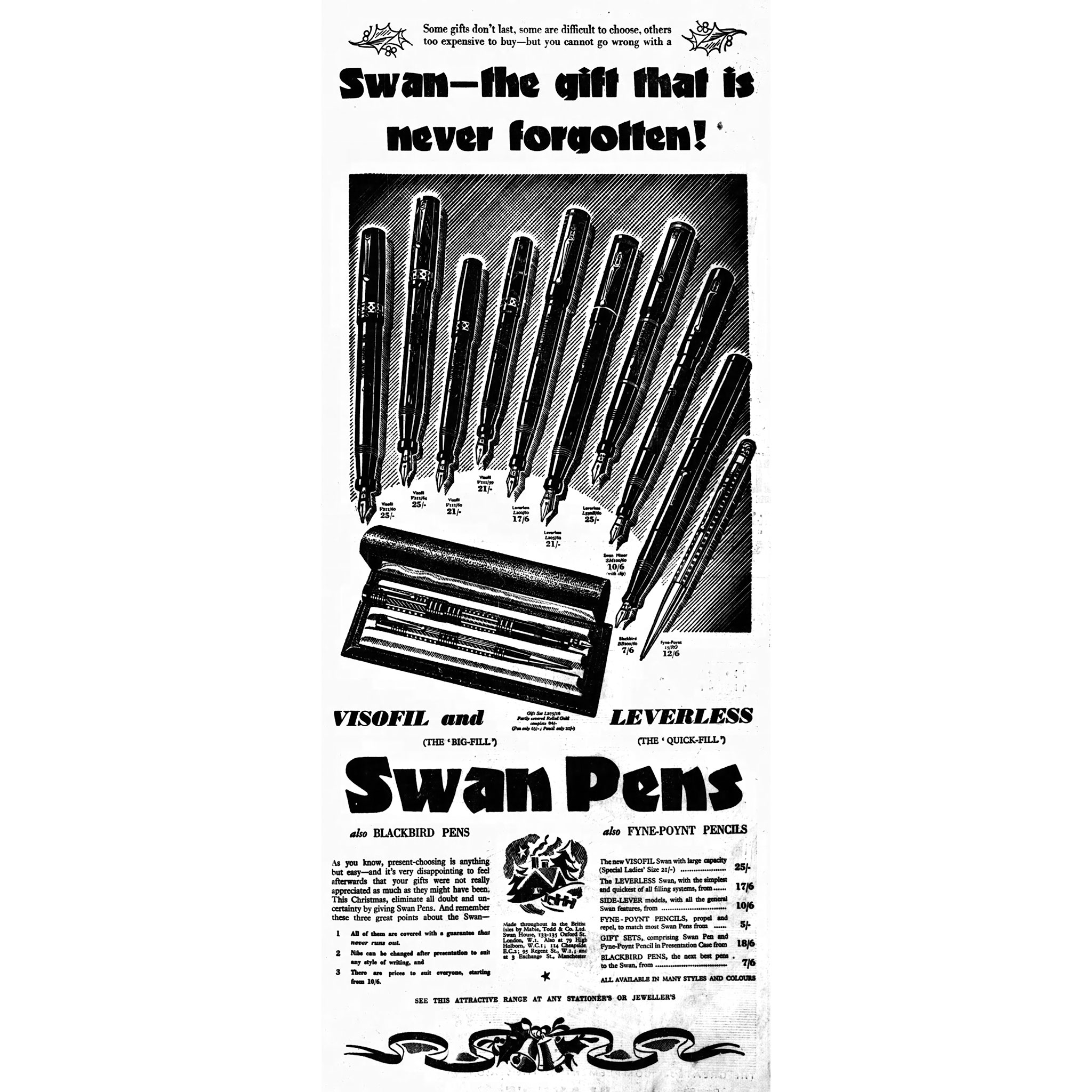 Swan advertisement showing Visofil and Leverless pens dated December 16, 1935
Swan advertisement showing Visofil and Leverless pens dated December 16, 1935
Following is a penography of the V-Series models, including spotting elements and colors available. Color names are the original Mabie Todd names and spellings. Visofil pens followed the Mabie Todd numbering system, where a Black V-Series full-size pen would be numbered as model V211 / 60. In this case, the “V211” is the pen model, the “2” is the nib size, and the “/ 60” indicates the Mabie Todd color number.
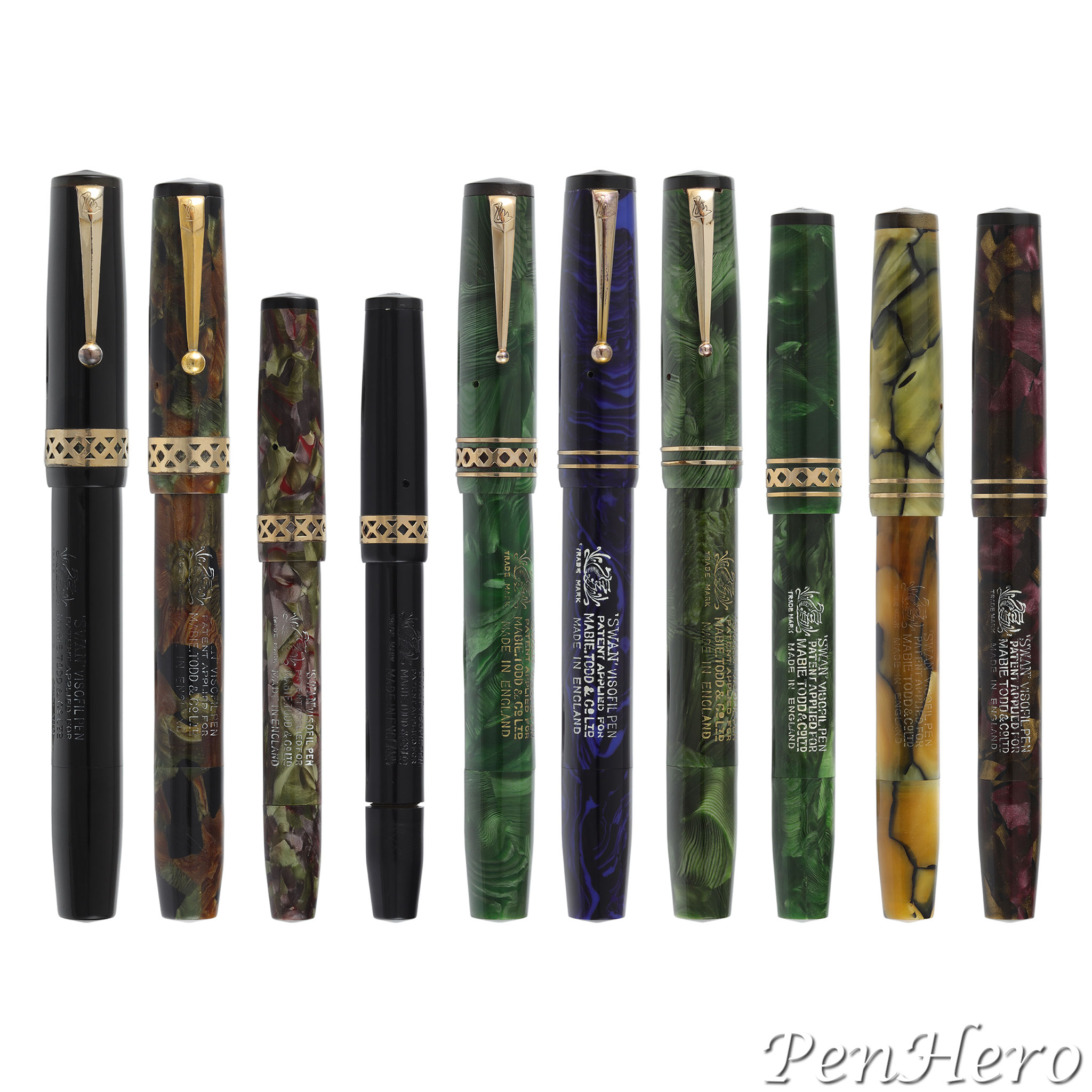 An array of Mabie Todd V-Series Visofil pens, described in detail below
An array of Mabie Todd V-Series Visofil pens, described in detail below
1935 V-Series Visofils
The first offering of the V-Series Visofil was in September 1935 and the line consisted of two models, a full-sized man’s pen and a very small clipless ladies’ pen. In general, the V-Series line followed the look and finish of the Mabie Todd Swan Leverless pens.
V211
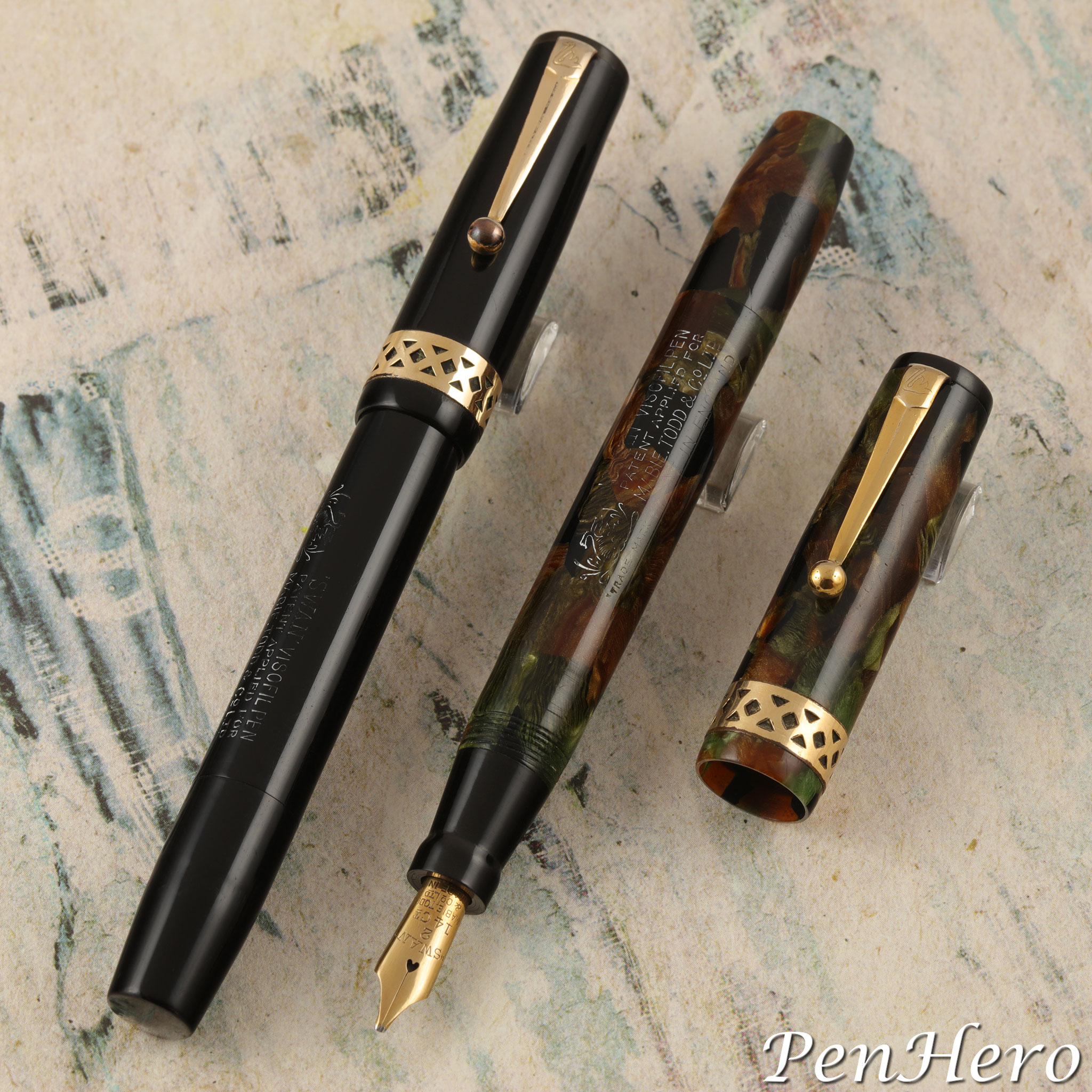 Mabie Todd Swan Visofil V211/60 Black and V211/63 Russet and Jade
Mabie Todd Swan Visofil V211/60 Black and V211/63 Russet and Jade
The early, large V-Series Visofil is the most commonly found model. Available with matching Fyne Point pencil at 7/6. The Fyne Point pencil also matched the Leverless pens.
Identification guide and features:
- Celluloid cap and barrel in the following colors, shown by the Mabie Todd color number and name: / 59 Italian Marble, / 60 black, / 63 Russet and Jade, / 64 Brown Amber, and / 67 Amethyst and Gold. A black pen would be model V211 / 60
- ¼-inch wide rolled gold filigree cap band
- Rolled gold washer clip with Swan logo stamped at top, split two-faceted tang, and large ball end
- Black hard rubber cap top with stamped and white highlighted Swan logo
- Conventional 14 karat gold nib, stamped SWAN 2 14CT MABIE TODD & CO LTD
- Nib is Mabie Todd no. 2, which is stamped on the nib face
- Nib grades included extra-fine, fine, medium, broad, and oblique, in firm and flexible
- Swan Visofil imprint, with the Swan logo, appears on the center middle of the barrel
- About 5 inches long capped and 6 1/8 inches posted
- Black hard rubber section
- Retail price 25 shillings
V111
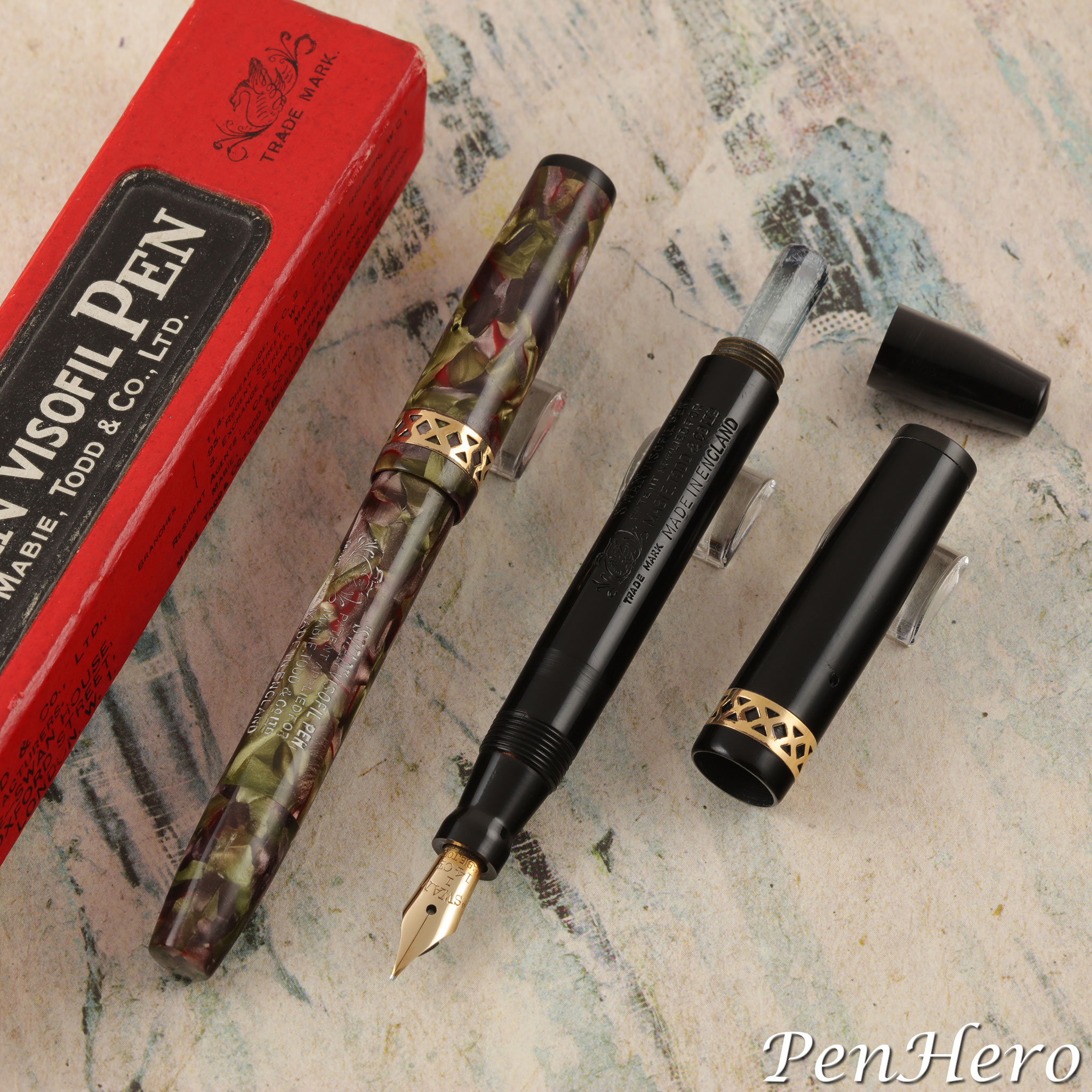 Mabie Todd Swan Visofil V111/59 Italian Marble and V111/60 Black
Mabie Todd Swan Visofil V111/59 Italian Marble and V111/60 Black
The V111 is a very small pen, similar in size to the dainty ring-top pens of the previous decade. The V111 followed the larger V211 in styling, though without a clip and smaller. The V111 was replaced by a larger pen in 1936 with the same model number. Available with matching Fyne Point pencil at 7/6.
Identification guide and features:
- Celluloid cap and barrel in the following colors, shown by the Mabie Todd color number and name: / 59 Italian Marble, / 60 Black, / 63 Russet and Jade, / 64 Brown Amber, / 67 Amethyst and Gold. A Brown Amber pen would be model V111 / 64
- 3/16-inch wide rolled gold filigree cap band
- Clipless
- Black hard rubber cap top with stamped and white highlighted Swan logo
- Conventional 14 karat gold nib, stamped SWAN 1 14CT MABIE TODD & CO LTD
- Nib is Mabie Todd no. 1, which is stamped on the nib face
- Nib grades included extra-fine, fine, medium, broad, and oblique, in firm and flexible
- Swan Visofil imprint, with the Swan logo, appears on the center middle of the barrel
- About 4 ¼ inches long capped and 5 1/8 inches posted
- Black hard rubber section
- Retail price 21 shillings
1936 V-Series Visofils
Several changes were made in the line for the second year of production, which began in October 1936. These changes included new colors, new trim, and two new models. The petite V111 was upgraded substantially in size.
V211
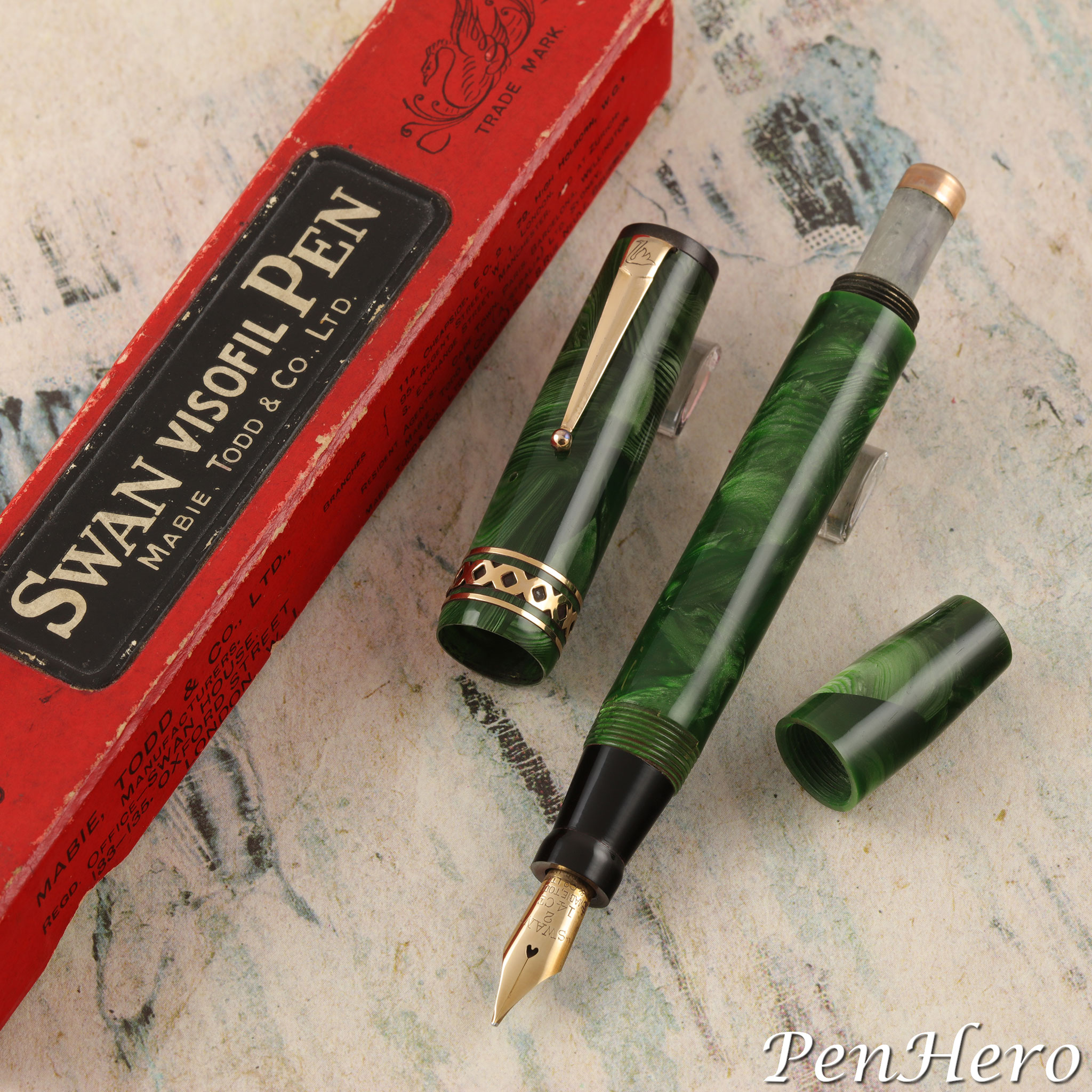 Mabie Todd Swan Visofil V211/66 Emerald
Mabie Todd Swan Visofil V211/66 Emerald
Several changes were made in the V211 in the second year of production, including new colors, splitting the filigree cap band into three pieces, and reducing the size of the ball on the clip. Available with matching Fyne Point pencil.
- Celluloid cap and barrel in the following colors, shown by the Mabie Todd color number and name: / 49 Imitation Mother-O’-Pearl, / 52 Blue, and / 66 Emerald. An Emerald pen would be model V211 / 66
- Two narrow rolled gold cap bands enclose a diamond filigree band, totaling 1/4-inch wide
- Rolled gold washer clip with Swan logo stamped at top, split two-faceted tang, and small ball end
- Black hard rubber cap top with stamped and white highlighted Swan logo
- Conventional 14 karat gold nib, stamped SWAN 2 14CT MABIE TODD & CO LTD
- Nib is Mabie Todd no. 2, which is stamped on the nib face
- Nib grades included extra-fine, fine, medium, broad, and oblique, in firm and flexible
- Swan Visofil imprint, with the Swan logo, appears on the center middle of the barrel
- About 5 1/8 inches long capped and 6 1/4 inches posted
- Black hard rubber section
- Retail price 25 shillings
V212
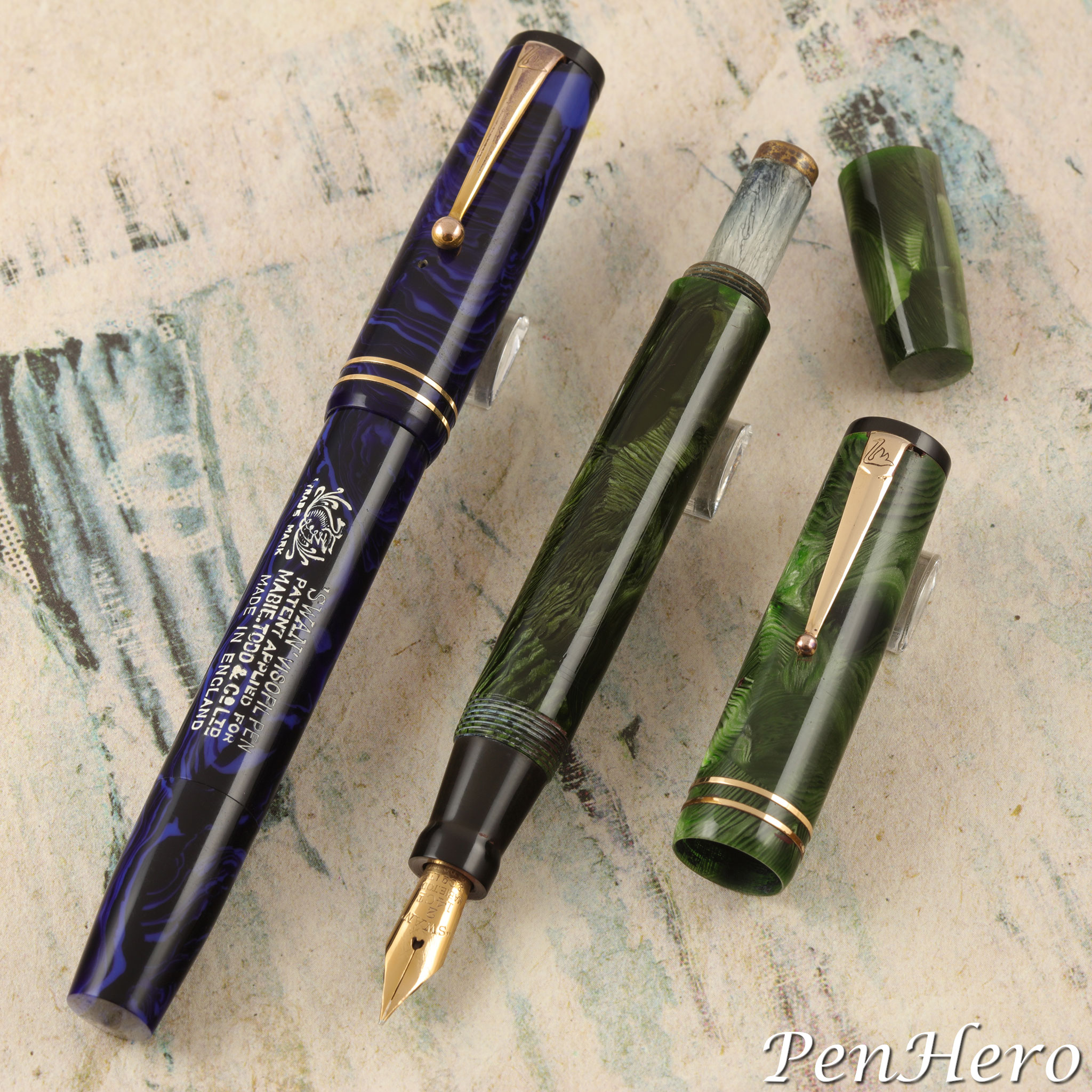 Mabie Todd Swan Visofil V212/52 Blue and V212/66 Emerald
Mabie Todd Swan Visofil V212/52 Blue and V212/66 Emerald
In October 1936, Mabie Todd introduced a two–cap band variation of the V211. It was essentially the same pen, in all other respects. Available with matching Fyne Point pencil.
Identification guide and features:
- Celluloid cap and barrel in the following colors, shown by the Mabie Todd color number and name: / 49 Imitation Mother-O’-Pearl, / 52 blue, and / 66 Emerald. A blue pen would be model V212 / 52
- Two narrow rolled gold cap bands
- Rolled gold washer clip with Swan logo stamped at top, split two-faceted tang, and small ball end
- Black hard rubber cap top with stamped and white highlighted Swan logo
- Conventional 14 karat gold nib, stamped SWAN 2 14CT MABIE TODD & CO LTD
- Nib is Mabie Todd no. 2, which is stamped on the nib face
- Nib grades included extra-fine, fine, medium, broad, and oblique, in firm and flexible
- Swan Visofil imprint, with the Swan logo, appears on the center middle of the barrel
- About 5 1/8 inches long capped and 6 1/4 inches posted
- Black hard rubber section
- Retail price 25 shillings
V111
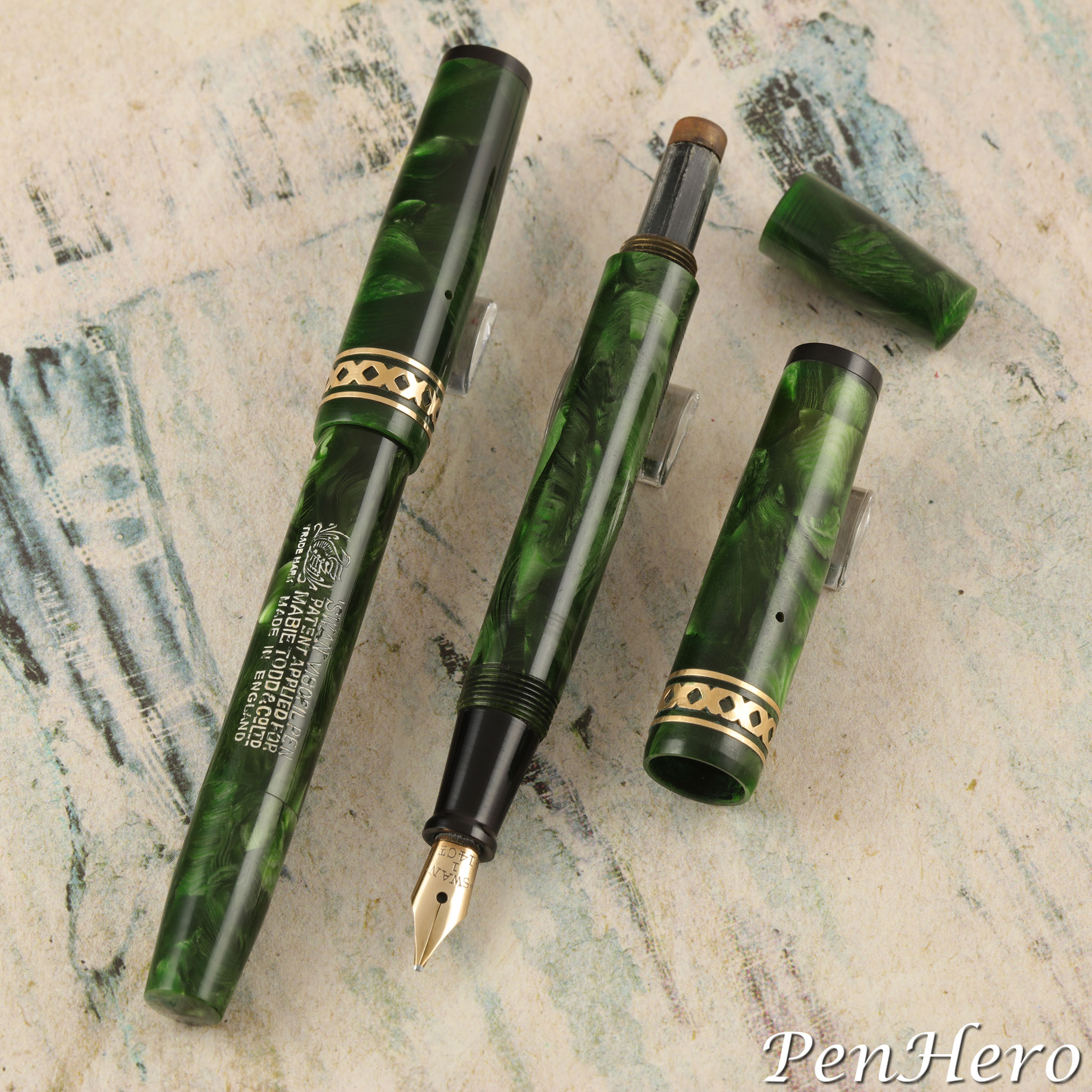 Two Mabie Todd Swan Visofil V111/66 Emerald pens
Two Mabie Todd Swan Visofil V111/66 Emerald pens
The V111 continued to follow the larger V211 as a ladies’ clipless version. In October 1936, Mabie Todd made the pen much larger and created a plainer version, called the V112, expanding the line for the ladies’ model. Available with matching Fyne Point pencil.
Identification guide and features:
- Celluloid cap and barrel in the following colors, shown by the Mabie Todd color number and name: / 49 Imitation Mother-O’-Pearl, / 52 Blue, and / 66 Emerald. An Imitation Mother-O’-Pearl pen would be model V111 / 49
- Two narrow rolled gold cap bands enclose a diamond filigree band, totaling 1/4 inch wide
- Clipless
- Black hard rubber cap top with stamped and white highlighted Swan logo
- Conventional 14 karat gold nib, stamped SWAN 1 14CT MABIE TODD & CO LTD
- Nib is Mabie Todd no. 1, which is stamped on the nib face
- Nib grades included extra-fine, fine, medium, broad, and oblique, in firm and flexible
- Swan Visofil imprint, with the Swan logo, appears on the center middle of the barrel
- About 4 3/4 inches long capped and 5 3/4 inches posted
- Black hard rubber section
- Retail price 21 shillings
V112
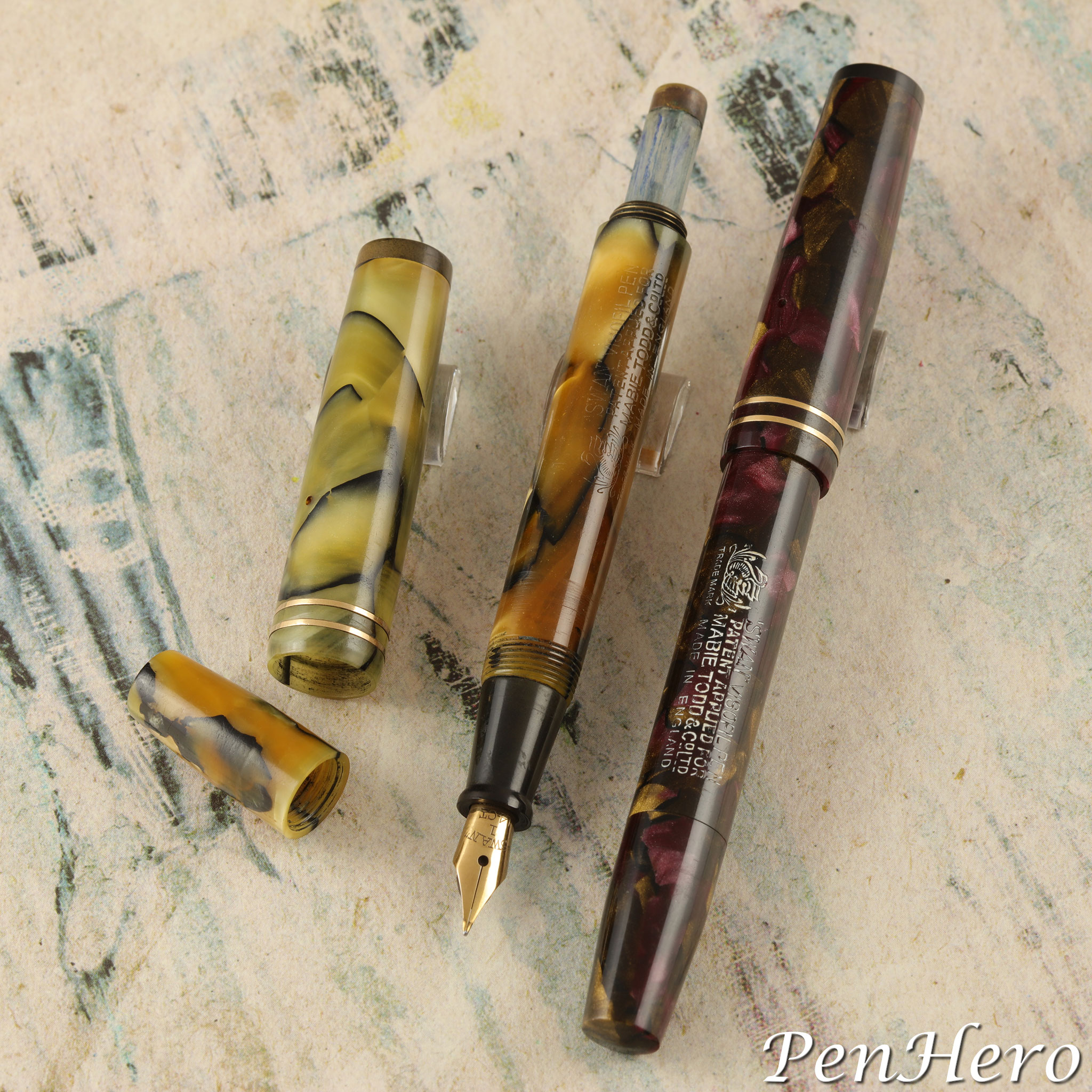 Mabie Todd Swan Visofil V112/49 Imitation Mother-O’-Pearl and V112/59 Italian Marble
Mabie Todd Swan Visofil V112/49 Imitation Mother-O’-Pearl and V112/59 Italian Marble
The V112 was introduced in October 1936 and is styled as a clipless variant of the V212 but is sized the same as the new and larger sized V111. Only trim differentiates the V112 and the V111. Available with matching A40 Fyne Point pencil at 10 shillings.
Identification guide and features:
- Celluloid cap and barrel in the following colors, shown by the Mabie Todd color number and name: / 49 Imitation Mother-O’-Pearl, / 52 Blue, / 59 Italian Marble and 66 Emerald. An Emerald pen would be model V112 / 66
- Two narrow rolled gold cap bands
- Clipless
- Black hard rubber cap top with stamped and white highlighted Swan logo
- Conventional 14 karat gold nib, stamped SWAN 1 14CT MABIE TODD & CO LTD
- Nib is Mabie Todd no. 1, which is stamped on the nib face
- Nib grades included extra-fine, fine, medium, broad, and oblique, in firm and flexible
- Swan Visofil imprint, with the Swan logo, appears on the center middle of the barrel
- About 4 3/4 inches long capped and 5 3/4 inches posted
- Black hard rubber section
- Retail price 21 shillings
Performance
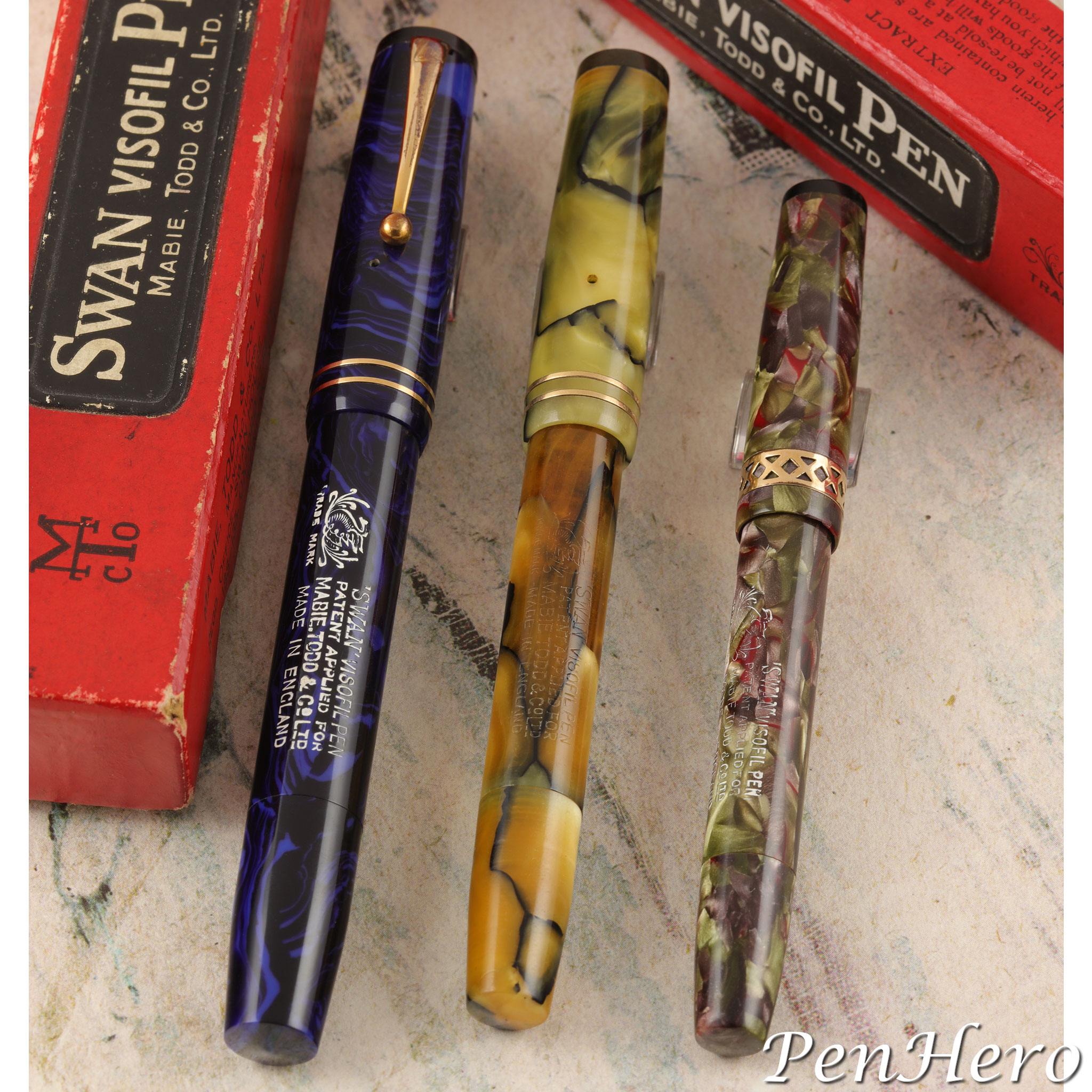 Mabie Todd Swan Visofil V-Series V212/52 Blue, V112/49 Imitation Mother-O’-Pearl, and V111/59 Italian Marble
Mabie Todd Swan Visofil V-Series V212/52 Blue, V112/49 Imitation Mother-O’-Pearl, and V111/59 Italian Marble
Filling a Visofil V-Series pen requires repeated pumping of the plunger until the ink level rises to where it can be seen in it, which is fun to watch. The filler design is quite unusual, with only the plunger indicating ink level, which is effective but requires the blind cap to be unscrewed to check.
If you are interested in having a copy of the original filling instructions, they can be downloaded from our Library Of Vintage Pen And Pencil User Guides at this link: Mabie Todd Swan Visofil V Series User Guide 1935.
Visofils are not common pens, especially in the United States. The only examples I have purchased have been from eBay or collectors in the UK. The full range of colors and the visual depth of the celluloid is very impressive. I have had the opportunity to see all the colors, and the blue and non-discolored Mother-O’-Pearl are most impressive. The Mother-O’-Pearl is probably the rarest color. Emerald and black appear to be the most common.
Though Visofil pens are uncommon, but I would not call them rare, they can be found in the United States and will command a moderately high price, like high-end Vacumatics. They are much more likely to turn up in the UK, and UK vintage pen dealers offer them from time to time. If you want one, make certain it has been serviced. Although not especially difficult to restore, the Visofil V-Series pens are serviced by a small number of repair people, and most of those are in the UK.
Laurence Oldfield told me, “The V [Series Visofil] pen represents [an] interesting evolutionary stage between sac pens and diaphragm pens. It is commonly thought of as a sac pen, but the addition of a long breather tube was a first step. All that would be required to make it a diaphragm pen would be to shorten the spring and attach the nib end of the sac to the middle of the barrel (rather than to the end of the section). This is what they did to create the VT.” The VT was the next Visofil model, which will be covered in an upcoming article.
Acknowledgements
Grateful thanks to Laurence Oldfield. A great deal of the information used to update this article, especially technical details and model information, is from his article “Pen Mechanisms Revealed—1. The Swan Visofil,” originally published in the Journal of the Writing Equipment Society (UK), November 2002, and is used with the permission of the author. Dr. Oldfield repairs Visofils and can be contacted at his website, penpractice.com.
Also, many thanks to Steve Hull who supplied the color identification and detail information about the different models of the V-Series Visofil pens from his work on Mabie Todd pens, The Swan Pen, Mabie Todd in England 1880–1960, which has been available since 2019. The book has 400 (full-color) pages and includes images of over 25 V series Visofil pens and pencils. It can be obtained at englishpenbooks.co.uk. Steve supplied the advertisements and patent details for Laurence Oldfield’s original article.
Pennant Summer 2022
This story appeared in the summer 2022 Pennant, the magazine of the Pen Collectors of America (PCA). You can learn more about joining the PCA and subscribing to the Pennant by clicking the link.
References
The Daily Telegraph, October 18, 1935, page 11
The Daily Telegraph, October 9, 1936, page 6
Great Britain Patent Specification 451,275, July 31, 1936
Liverpool Echo, December 16, 1935, page 9
United States Patent 2,056,055, September 29, 1936
Interact
Comments on this article may be sent to the author, Jim Mamoulides


